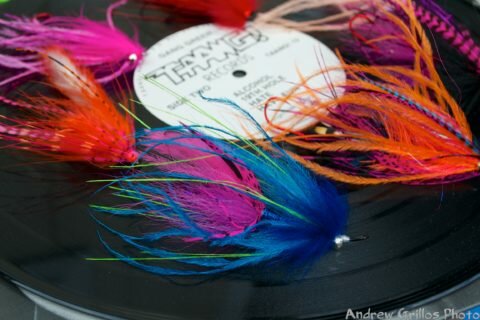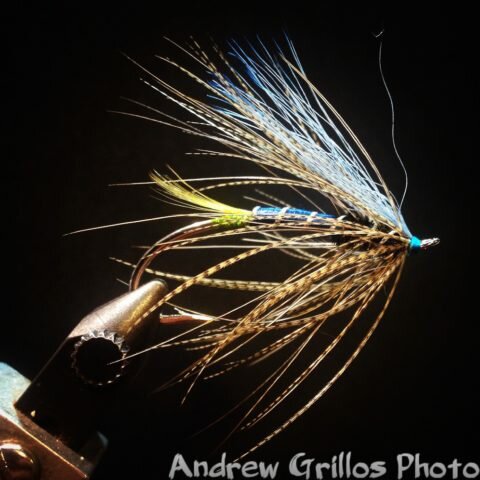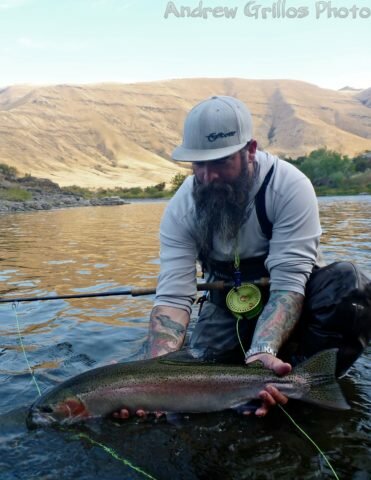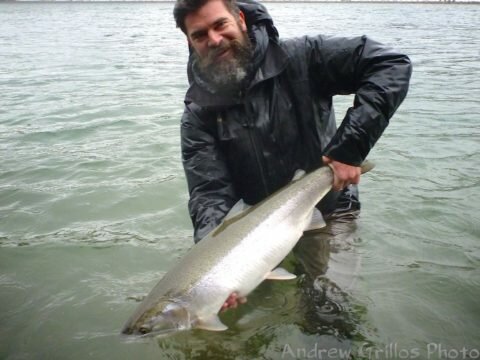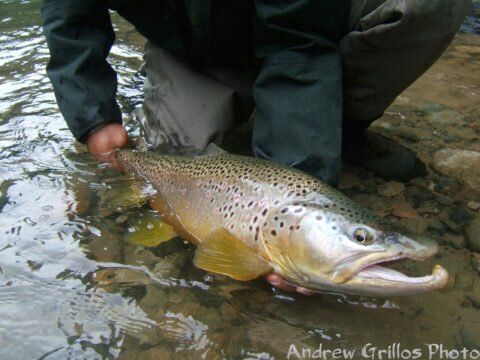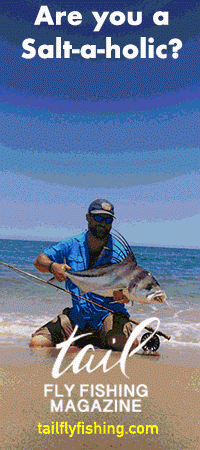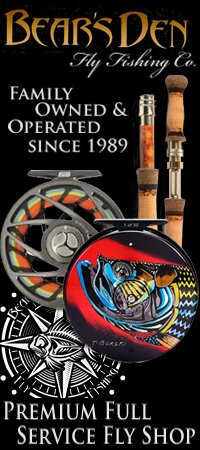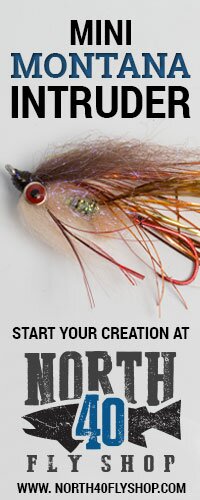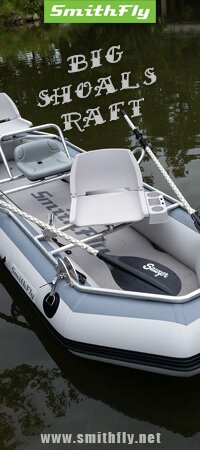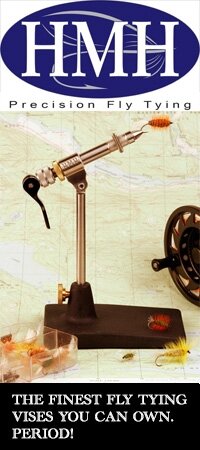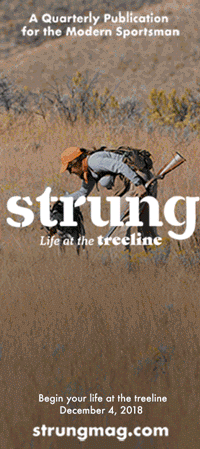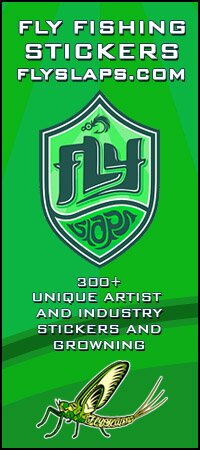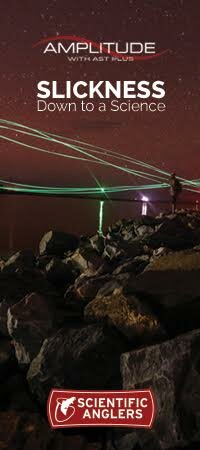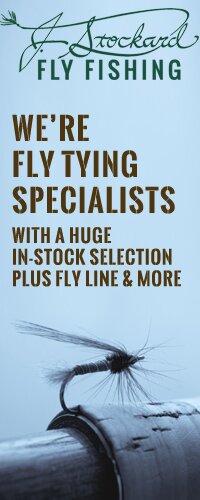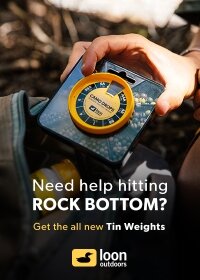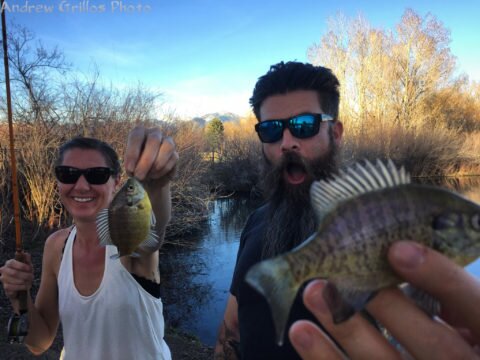
Tell us a little about yourself and how you got into the world of fly fishing?
Growing up in Colorado, I always loved recreating in the outdoors. However, for some reason fishing never really clicked with me until I found fly fishing. I think fishing with a worm and bobber was just too boring for a little kid whereas fly fishing was so active and intriguing. I was hooked the first time I tried to cast a fly rod.
Did you have a mentor of any kind? Someone that you learned a lot from or was inspired by when fly fishing or fly tying?
My stepdad and I definitely learned to fly fish together. It was pretty much trial by fire for us, we’d go out and catch the bushes, bullwhip our flies off, and generally struggle. Somehow every time we went out we had fun and we slowly began to figure things out and eventually we experienced a little success! Our local fly shop was the St. Vrain Angler, in Westminster, Colorado and I recall getting a great deal of help and advice from the shop’s manager, Mike Briscoe. As any good fly shop employee should, he was always a great source of helpful info whether it was fishing or tying. I recall running into him when I was working at the Simms booth at the ISE show in Denver in maybe 2009 and we talked about all the things I had done over the something like 15 years since I had last seen him. It was great catching up with someone that was super helpful to a random kid that was obsessed with fly fishing at a young age. I also have to say I’ve never met Scott Sanchez but I remember seeing some fly articles of his from the 90’s and they were definitely an inspiration to me at a young age. I started tying foam dries over 20 years ago and his flies were some of my earliest foam fly inspirations.
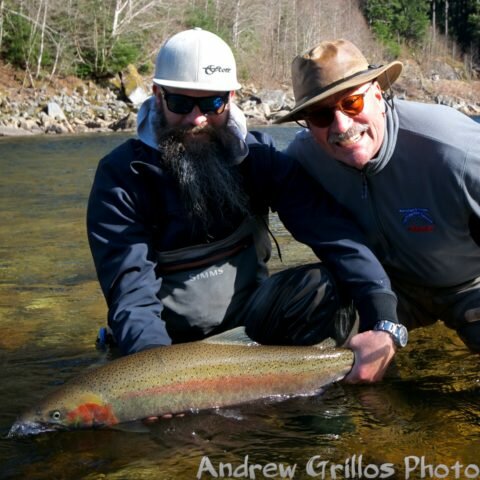
What species do you fish for most often these days?
I’m pretty happy fishing for most anything that swims! Living in Bozeman is great as we’ve got so many great and diverse trout fisheries within an hour or two of home. I spend a lot of time on bigger water swinging flies for trout, I really enjoy the simplicity of walking out to the river with a spey rod and a Ziploc bag with a few flies in it. It’s definitely the opposite of a day of more traditional trout fishing where I’ve got my waist pack with way too many fly boxes. Of course I love steelhead fishing, whether it’s summer fish or winter fish. It’s a bit more of a production to chase steelhead since I moved away from the Pacific Northwest, however I still manage a few trips a year! I also love the visual aspect of carp fishing. When things get super hot in Montana in July and August we spend a fair amount of time chasing carp as well. It’s always fun when you can sight fish for bigger than average fish!
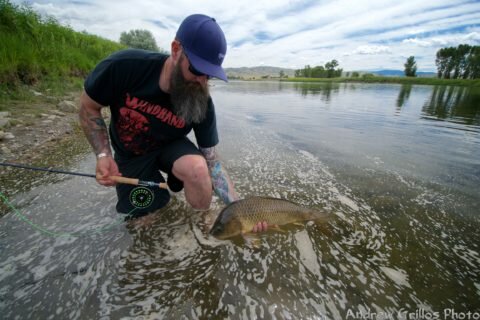
What would you say to other fly fisherman out there that aspire to be a guide?
A few years ago a young guy made contact with me through my website asking that very question. I gave him my best advice and have kept in touch with him ever since. He seems to be a well respected guide and is guiding year round now, splitting his time in the Northern hemisphere and Southern hemisphere. I do feel like he took my advice to heart and has done well for himself. As I recall the advice I gave him was to just focus on doing the best job you can at showing people a good time in the outdoors. Don’t focus on social media so much, there are way too many Insta-pros out there these days whereas the real guides are getting shit done day in and day out, head down, just working and showing their people a good day. Integrity and a good reputation are earned, not made on Facebook. Similarly, a big repeat client base is earned through hard work and consistency on the water, not time spent pushing yourself on the world. I felt like keeping more to yourself and doing a good job for your clients, outfitters, and other river users goes much further than just hyping yourself on social media.
What makes a good client to guide in your book?
Anyone with a positive attitude and realistic expectations was pretty much all I asked for. Whether it was a day with a total beginner chasing tiny trout in a small stream or a day spent swinging flies for winter steelhead, attitude and expectations are everything. If they were my own clients I always made sure to set expectations properly for our day from the get-go. The first year I was guiding in the Seattle area I was taking some trips for a Seattle fly fishing outfitter that set client expectations insanely high just to get them booked and take their money. It was not a good seutp and didn’t last…. It made life so much more difficult for me and made for generally unhappy anglers. Once he had passed them on to me I was stuck with people that were surprised that we weren’t going to catch multiple winter steelhead on their first day with a spey rod or I had to tell them that a good day in Puget Sound was catching a dozen sea run cutthroats that average 10 inches, not a few dozen sea run cutthroats averaging 16 inches and catching a few over 20! Again, attitude and realistic expectations make or break a day of guided fishing.
Would you describe a couple of your rod setups for the species you are most commonly fishing for? For example, the size and type of fly rod, line, and leader you use?
For a regular day of trout fishing here in MT I’m usually fishing a Scott Radian, 4wt or 6wt depending on where and what I’m doing. I love the 4wt for most dry fly or dry and dropper fishing. I usually fish a 6wt if I’m going to be nymphing or throwing streamers most of the day. For carp fishing I like the Scott Meridian 6wt. It’s got the power and accuracy to hit a target a long ways out if need be. As far as spey rods go I’ve got a bit of a problem, I have something like 20 spey rods, all Scotts, from 4wts to 9wts. I’m pretty well covered from swinging soft hackles for trout on the Madison to fishing for winter steelhead or kings in the NW. I love old and interesting reels as much as I like taking a brand new Hatch out of the box as well. If I need a new, high performance reel, I usually reach for one of my Hatches, however I’ve got some Ari T Hart reels, some old Hardys, and some other odds and ends that see regular use too. Also, I have to say my favorite trout reels of all time are my Ross San Miguel 3s. They’re just such a timeless, good looking, and smooth performing reel.
Could you describe some of the fly patterns you have available commercially?
Well, the Hippie Stomper is my most widely known fly pattern. Umpqua is currently offering 11 different colors of hippie stomper in sizes 8-18. It’s a pretty cool feeling knowing that I came up with a fly that’s pretty much become a standard in most fly shops. Unfortunately, it’s done so well there are at least 3 or 4 fly companies that have been selling Hippie Stomper knock offs at this point. As frustrating as it is knowing that they’re blatantly ripping off my fly that is officially produced through Umpqua, it’s more frustrating seeing how poorly these companies’ copies are tied. -Which I guess is a good thing in a way, most dealers know the originals are from Umpqua and buying the terrible quality knock offs is usually a mistake dealers only make once.
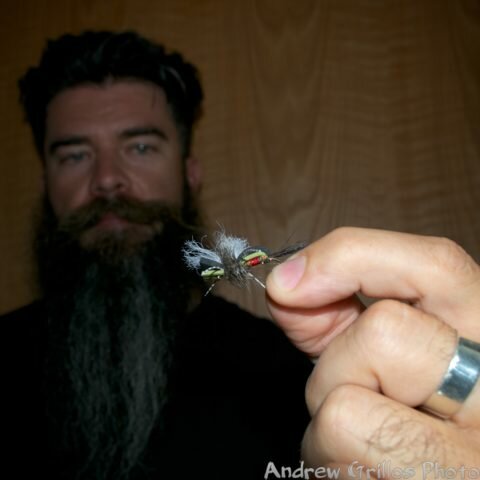
I’ve got a number of other flies that Umpqua produces, my El Camino stonefly is one of my favorite stone dries that I’ve come up with. It sits lower in the water but is still easy to see and fishes really well. My 64 Impala is a similiarly styled stonefly, only supersized to match the salmonflies on most Western rivers. I’ve got a mouse pattern that I dialed in while guiding in Alaska, the Bob Gnarly. It’s a nearly indestructible mouse that incorporates a styrofoam strike indicator as its core. My Laser Pointer is a dry fly that utilizes angel hair for the indicator on it, rather than some sort of neon yarn. It sparkles from far away, so it remains visible even though it’s a mostly dark/black dry fly. My Heavy Metal Worm is the combination of two really dirty trout flies, the wire worm and the rubber band worm. It’s sparse and heavy, so it gets down without much additional weight.
What are your two newest flies that are available commercially?
I had a good year with fly submissions in 2016, I’ve got 4 or 5 new patterns coming out for 2017. My Captain Crunch is a fly I tie mainly for trout spey however it’s proven itself for summer steelhead as well. It’s a killer sculpin-inspired mashup of a muddler, intruder, and flash fly. Also, there are few things more fun than having a steelhead boil on a waking/skating fly, and Umpqua’s started producing my Boilermaker, which is basically a waking green butt skunk. I’ve got a foamy, buggy, caddis-y guy that’s been really effective for me, the Party Animal. I also offered my El Camino stonefly in a Skwala color combo. They’re an interesting hatch that I never really saw until I moved from Colorado to the NW. The skwala hatch is a pretty big deal because it’s an early season hatch, typically around March, and it’s a great way to start the year out fishing size 10/12 dry flies. I was surprised to see how well the trout reacted to skwalas in the Yakima River in Washington for the first time. Beyond the Yakima, there are as a few other Idaho and Montana rivers that have notable skwala hatches as well.
Do you have any new flies you are currently working on?
Always! I’m constantly thinking of fly ideas and how to tweak other flies to make them better. I’ve got a really cool low-riding mayfly profiled guy already done and lined up for Umpqua’s 2018 offerings. I’ve been dialing in a number of different general nymph patterns I’ve been messing with for a few years. I was inspired by a couple spinner falls I fished two summers ago, so I’ve got a spinner pattern in the works. Of course I’m always messing with summer and winter steelhead flies just because they’re so fun to tie. They’re a little bit more of a niche market, but Umpqua’s currently got a few of mine in for review that I think are winners.
What is your process like when designing a new fly?
I’m usually trying to solve a problematic fishing situation that I might encounter or an angler might have while fishing. Most of my flies are intended on being as user-friendly as possible, whether it’s durability, floatability, or visibility, those are the three key factors that I keep in mind when tying dry flies. I usually will have an idea so it goes in my phone’s “fly ideas” list that I’m constantly updating. I’ll then tie a few initial flies to try to get the fly to look how I think it should. At this point I’ll go out and fish the fly and see if it does what I want. From there I’ll continue to tweak the pattern until I’m really happy with the fly’s performance and when I don’t think I can make the fly any better. I’m also inspired by materials rather than just fishing situations. I’ll see some material that I’m not super familiar with and I’ll instantly think of how I can use it.
Can you tell us about your time in Washington State chasing steelhead?
Steelhead are a fun and interesting fish to pursue for sure. Regarding winter steelhead, they’re super cool because you can potentially be fishing to a big, hot fish that’s never seen a fly before. Summer steelhead are more trouty in my opinion, they will move further to inspect a fly, they’ll hit a waking fly on the surface, and they can track surprisingly small swung flies. I’ve caught summer steelhead swinging tiny size 12 and 14 hairwings in pretty decent current. A big pet peeve of mine is hearing steelhead referred to as unicorns. There’s nothing magical about them! There’s just not that many of them around so crossing paths with them is a less frequent occurence! Being patient and present is the biggest key to steelhead fishing I think. They are a low numbers fish in general, it’s not like a day of trout fishing where you might be fishing over hundreds of trout. Depending on the river and the timing you might cross paths with one or two steelhead in a days fishing. Also, there are so many different ways to fish for them and I really don’t think one way is better than the other as long as the fish and the resource is treated with respect. I prefer fishing for steelhead with a swung fly whether it’s a summer run on a skater casting a long belly line, or a winter steelhead on a short Skagit head and a big nasty fly. However, I also enjoyed fishing a float and beads/yarn and spoons for them while in the NW. I learned so much more about the fish and where to find them by fishing gear. I think some of the most closed minded and least effective steelhead anglers on the river are usually the most uppity “swing-only” guys who have never gear fished and have never really tried to learn where the fish hold in any given situation.
What are some of the things you would think about when designing a fly for steelhead specifically?
Castability, profile, and movement are the key factors to me when tying a winter steelhead fly. It’s easy to tie a fly with a big profile, look at modern musky flies. They’re insane! What’s tricky about winter steelhead flies is tying a fly that will hold a decent 3-5 inch long profile in the water, will still sink quickly, and will be easy to cast. Basically going for the illusion of bulk.
Summer steelhead flies are kind of the opposite to me, small flies that are elegant and fun to tie and have color combos that are aesthetically pleasing. I love tying perfect little hairwings, there’s something really pleasing about tying what I think is a perfectly proportioned fly while keeping in mind that less is more.
If a fly tier was trying to design a skater for steelhead, how would that differ from say, a popper for bass?
Well, castability is the first difference that comes to mind. I think a steelhead would totally hit a bass popper waking across a greasy tailout, but it’s a matter of casting it out there and presenting it. I do believe steelhead are curious fish by nature and they inspect things by grabbing them with their mouths.
Could you describe one or two of your most memorable fish that you have caught?
How about highs and lows?
On a recent trip to the NW I caught what I’ve gotta say is my favorite winter steelhead I’ve ever caught. I’ve been lucky enough to have caught some steelhead bigger, but the hen I landed on my trip in January was just the most perfect specimen I’ve ever touched. It was maybe a day or two out of the salt with clear fins and basically zero color. It was just such a fun fight and special experience on one of my favorite rivers in the world. It came on a big cast in one of my favorite runs in the river. Relatively early in the swing I got a hard grab and the fish instantly did a huge cartwheel a few feet out of the water. Then is was warp speed into the backing, multiple long runs back and forth, and then finally dogged it out in close for maybe 5 minutes before I was able to tail her.
Another one of my most memorable fish was (unfortunately) caught by the worst person I ever guided in my 13 year career. The guy was just a horrible, unhappy, mean guy. I probably have enough from 6 days with him in Chile to write a book on how not to act at a remote fishing lodge… Anyway, we were fishing a fairly isolated canyon section of a river in Chile and I had my anglers casting streamers on sink tips. The guy in the front of the boat starts yelling about something so I look and there’s a huge fish following his streamer maybe 50 feet out. The fish followed his fly for at least 20 feet and then casually ate. Crazy guy actually kept cool and let it eat, hooked it well, and we landed a totally perfect 28” hook jawed brown. That might be one of the most perfect trout I’ve ever seen.
Do you have any advice for new fly tiers out there?
Focus on the basics first. Pay attention to proportions. Try not to make a bunch of unnecessary thread wraps, it just adds bulk and makes for a sloppy fly. As tough as it is, don’t crowd the eye of the hook. Tie lots of basic, standard flies and try to get them to look as good as the commercially tied ones at the fly shop. That practice will pay off more than anything. Admittedly, I spend too much time browsing flies on instagram and I just see so much garbage on there because people try to tie things that are well above their skill set. Don’t get me wrong, please push yourself, but I see too many flies that are tied lacking basic fundamentals that would clean up an otherwise terrible looking fly.
Do you have anything else at all you would like to add?
I’m really thankful to have made my living taking people fishing all over the world for as long as I did. I’m no longer guiding however I still tie flies like a maniac and I enjoy my time on the water now more than ever!
Thanks for the interest Paul!

